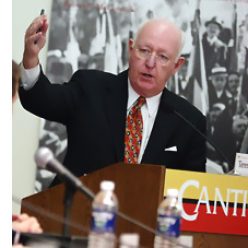TEDDY KOLLEK
The quiet passing the other day of Teddy Kollek, the longtime Mayor of Jerusalem, got me to thinking about the man and his moment in history. The Kollek story got lost amid all the commotion last week surrounding the execution of Saddam Hussein and the funeral for former President Ford. It deserved more attention.
Teddy was no angel, but he was indisputably the right man in the right place when, 40 years ago this year, the divided city of Jerusalem was united overnight and Israelis and Palestinians began the messy business of living side-by-side. It was never going to be easy, but Teddy Kollek made it work a lot of the time. He represented the kind of pragmatic approach that seems so scarce in the Middle East these days and yet is essential if there is ever to be a workable peace between Israel and Palestine.
Managing Jerusalem’s split personality required all of Teddy’s energy and optimism over the 28 years he served as its Mayor. He often said he would have preferred a city without Arabs, but since they were there, he did what he could to improve the services in East Jerusalem and treat its citizens fairly, if not equally. He didn’t hesitate to raze the Arab neighborhood in front of the Western Wall to clear it for Jewish worshipers, but at the same time he built gardens and parks and theaters and new roads throughout the city.
The Arabs of Jerusalem tolerated him, nothing more. When he died, a prominent Fatah leader and Jerusalem resident, Khatem Abdel-Qader, was quoted as describing him as “a respectable Israeli figure.” In today’s heated rhetoric, that passes for high praise.
I first met Theodore Herzl Kollek in June, 1967, just before the start of the six-day war. I had just arrived in Jerusalem as the new correspondent for The New York Times and I called the Mayor’s office to see if I could interview him in the next week or two. “What are you doing right now?,” he demanded, and 15 minutes later he was in front of the King David hotel in his green Dodge. “Let me show you my city,” he said as we drove off.
That was Teddy’s style: brash, incredibly energetic, always optimistic. On our little tour, he showed me the barbed wire and no-man’s land that divided the Israeli and Arab sectors and the ramshackle Mandlebaum Gate that connected them. “Some day that will be gone,” he said, and in a few days, after Israeli forces captured the whole of Jerusalem, it was.
Our apartment in the Rehavia section of Jerusalem was a few doors from his. I could see him bound down his front steps at dawn ready to solve all the city’s problems in a day, and then return, his barrel-chested body slumped with fatigue, trudging up those same steps well after dark. Lots of problems remained unfixed, of course, but no one worked harder than Teddy.
Who are the Teddy Kolleks today? Where are the political leaders to bridge the bitter gap that has grown up between the Israelis and Palestinians over the last 40 years? Which Israelis and who are their Arab counterparts?
After 28 years in office, from 1965 to 1993, at age 82, Teddy lost his sixth bid for re-election to Ehud Olmert, now the Prime Minister. Does Olmert have the tolerance and openness to embrace the Palestinians as Teddy did?
Kollek didn’t paper over or ignore the differences between his Israeli and Arab constituents. He tried to get things done despite them. Even after he was out of office, he continued to improve the city by raising millions for the Jerusalem Foundation.
For all his energy and optimism, Teddy Kollek couldn’t achieve complete or lasting harmony in Jerusalem. But he died trying
